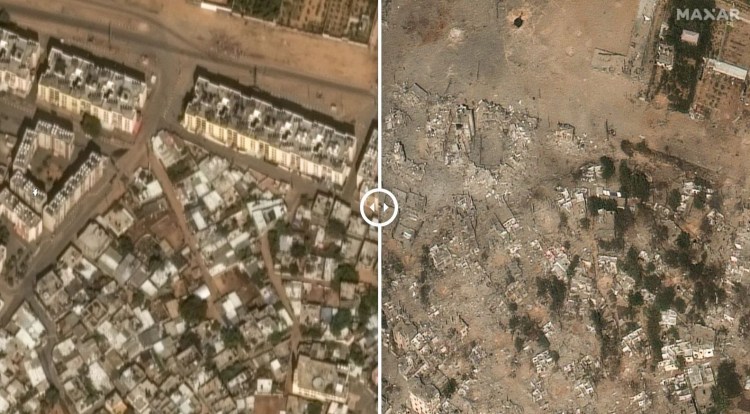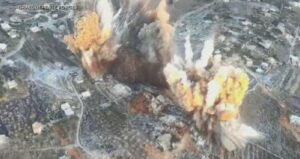The Historical Roots of the Israel-Palestine Conflict
On 7 October 2023, the Hamas quasi-government of Gaza, perpetrated a massacre in Southern Israel. Hamas militants surged across the border in a coordinated assault, overwhelming local Israeli garrisons. Men, women, and children were indiscriminately butchered. Reporting indicates that Hamas took approximately 240 Israeli hostages, and Hamas has been using negotiations to incrementally release hostages under the framework of a ceasefire–an attempt to control the tempo and timing of Israel’s counter-offensive in Gaza.
The return of the Jews to their ancestral home is often cast as a reparation from a guilty world for the horrors of the Holocaust that came at the expense of Palestine’s indigenous inhabitants. Political support for Zionism (the global return of Jews to their ancestral homeland) began in the well-meaning minds of British Prime Minister Lloyd George’s Cabinet during the Great War (World War I). George’s Cabinet observed that the Jews were frequently treated as an other—an outsider caste—all across Europe. It was difficult to fully integrate the Jews into the mainstream cultures of the continent, because they had their own religion and customs. The proposed solution was to give them a home of their own in the Holy Lands of the withering Ottoman Empire.
In the Balfour Declaration of 1917, the United Kingdom announced its intention to work with Jewish communities for the establishment of a “National home for the Jewish people” in Palestine. When the Ottoman Empire collapsed at the end of the Great War, France and Britain signed the Sykes-Picot Agreement which carved up former Ottoman territories between them. The League of Nations soon recognized this agreement and issued a mandate for French and Anglo administration of the Middle East. The UK would administrate Palestine, Transjordan, and Iraq, as well as the port cities of Acre and Haifa. The French would administrate Southern Turkey, Lebanon, Kurdistan (Northern Iraq), and Syria.
While much of the Jewish diaspora emigrated to Palestine with the help of European governments, there were already many Jews still inhabiting Palestine – descendants from the ancient Kingdom of Israel. In fact, the Jews constituted an ethnic majority in the Holy City of Jerusalem.
The region’s Arab Muslims, who eventually became known as Palestinians, were largely Bedouin nomadic tribesmen (the inhabitants of Gaza City and Jerusalem were notable exceptions). They migrated freely between Iraq, Syria, Transjordan, Lebanon, Palestine, Sinai, and Arabia. It was the influx of European agricultural techniques, and especially the rediscovery of ancient regional water resources by agronomist Aaron Aaronsohn that enabled the Palestinian peoples to settle, urbanize, and grow in numbers.
In 1890, prior to the arrival of any Jewish immigrants or the Zionist Movement, there were only approximately 432,000 Arab Muslims living in all of Palestine. By the end of the British Mandate in 1947, the Arab Muslim population had grown to approximately 1,180,000 (the Ottomans, British, and Palestinian Central Bureau of Statistics do not significantly differ in their census statistics). By 2000, the number had grown to 3,891,000. The CIA World Factbook currently estimates that 2.16 million Arabs live in the West Bank, 1.84 million Arabs live in Israel, and 1.79 million Arabs live in the Gaza Strip—totaling 5.79 million (does not include Palestinians living abroad).
Missed Opportunities for Peace
Israel has negotiated in good faith for a two-state solution on several occasions, and on each occasion the Palestinians (often goaded by the Arab states around them) have walked away from the table.
Following the 1936 Arab Revolt, London attempted to broker a deal where the Arab Muslim Palestinians would receive 80% of the disputed land and the Jews 20%. Jerusalem would remain under British administration. The Jews accepted the deal, but the Palestinians did not.
The Historical Roots of the Israel-Palestine Conflict
On 7 October 2023, the Hamas quasi-government of Gaza, perpetrated a massacre in Southern Israel. Hamas militants surged across the border in a coordinated assault, overwhelming local Israeli garrisons. Men, women, and children were indiscriminately butchered. Reporting indicates that Hamas took approximately 240 Israeli hostages, and Hamas has been using negotiations to incrementally release hostages under the framework of a ceasefire–an attempt to control the tempo and timing of Israel’s counter-offensive in Gaza.
The return of the Jews to their ancestral home is often cast as a reparation from a guilty world for the horrors of the Holocaust that came at the expense of Palestine’s indigenous inhabitants. Political support for Zionism (the global return of Jews to their ancestral homeland) began in the well-meaning minds of British Prime Minister Lloyd George’s Cabinet during the Great War (World War I). George’s Cabinet observed that the Jews were frequently treated as an other—an outsider caste—all across Europe. It was difficult to fully integrate the Jews into the mainstream cultures of the continent, because they had their own religion and customs. The proposed solution was to give them a home of their own in the Holy Lands of the withering Ottoman Empire.
In the Balfour Declaration of 1917, the United Kingdom announced its intention to work with Jewish communities for the establishment of a “National home for the Jewish people” in Palestine. When the Ottoman Empire collapsed at the end of the Great War, France and Britain signed the Sykes-Picot Agreement which carved up former Ottoman territories between them. The League of Nations soon recognized this agreement and issued a mandate for French and Anglo administration of the Middle East. The UK would administrate Palestine, Transjordan, and Iraq, as well as the port cities of Acre and Haifa. The French would administrate Southern Turkey, Lebanon, Kurdistan (Northern Iraq), and Syria.
While much of the Jewish diaspora emigrated to Palestine with the help of European governments, there were already many Jews still inhabiting Palestine – descendants from the ancient Kingdom of Israel. In fact, the Jews constituted an ethnic majority in the Holy City of Jerusalem.
The region’s Arab Muslims, who eventually became known as Palestinians, were largely Bedouin nomadic tribesmen (the inhabitants of Gaza City and Jerusalem were notable exceptions). They migrated freely between Iraq, Syria, Transjordan, Lebanon, Palestine, Sinai, and Arabia. It was the influx of European agricultural techniques, and especially the rediscovery of ancient regional water resources by agronomist Aaron Aaronsohn that enabled the Palestinian peoples to settle, urbanize, and grow in numbers.
In 1890, prior to the arrival of any Jewish immigrants or the Zionist Movement, there were only approximately 432,000 Arab Muslims living in all of Palestine. By the end of the British Mandate in 1947, the Arab Muslim population had grown to approximately 1,180,000 (the Ottomans, British, and Palestinian Central Bureau of Statistics do not significantly differ in their census statistics). By 2000, the number had grown to 3,891,000. The CIA World Factbook currently estimates that 2.16 million Arabs live in the West Bank, 1.84 million Arabs live in Israel, and 1.79 million Arabs live in the Gaza Strip—totaling 5.79 million (does not include Palestinians living abroad).
Missed Opportunities for Peace
Israel has negotiated in good faith for a two-state solution on several occasions, and on each occasion the Palestinians (often goaded by the Arab states around them) have walked away from the table.
Following the 1936 Arab Revolt, London attempted to broker a deal where the Arab Muslim Palestinians would receive 80% of the disputed land and the Jews 20%. Jerusalem would remain under British administration. The Jews accepted the deal, but the Palestinians did not.
In 1947, the British asked the UN to resolve the dispute. The UN proposed a two-state solution with Palestine evenly divided between Jews and Muslims—the 1947 Partition. The Jews accepted the deal, but the Palestinians did not.
The British Mandate was repealed in 1948 and Israel declared itself a nation. Immediately following the end of British rule, all neighboring Arab countries declared war and invaded the regional Jewish settlements. Somehow the Nation of Israel emerged victorious over Lebanon, TransJordan, Iraq, and Egypt simultaneously. It was the Palestinians who were pushed back to their current borders in the West Bank and Gaza Strip, both of which were occupied and administrated by TransJordan and Egypt, respectively.
In 1967, Egypt closed the Straits of Tiran to Israeli shipping, and then Egypt, Syria, Jordan, and Iraq amassed large ground forces on the Israeli border. Israel conducted a pre-emptive strike, destroying the Egyptian Air Force while it was still on the ground. After 6 days of fast-moving ground conflict, Israel won another decisive victory. The Six-Day War allowed Israel to secure the West Bank, the Gaza Strip, and the Sinai Peninsula in order to create better defensive depth.
The Knesset (Israel’s Parliament) deliberated on what to do with these new territories. The Knesset seriously considered establishing an independent Palestinian State in these territories on its own accord. Other proposals included giving the West Bank and Gaza back to Jordan and Egypt in exchange for recognition and peace. Deliberations were cut short when the Arab League issued its 1967 declaration of the Three No’s: No Peace with Israel, No Recognition of Israel, No Negotiations with Israel.
In the 1973 Yom Kippur War, Egypt and Syria led a coalition of Arab states in a surprise invasion of Israel. Egypt’s incursion into the Sinai was initially very successful, but in order to relieve pressure on Syrian forces in the north, Egyptian forces pushed forward beyond the reach of their air defense networks. Israel counter-attacked and won another decisive victory.
In 1979, Egyptian President Anwar Sadat signed the Egypt-Israel Peace Treaty with Israeli Prime Minister Begin. In normal times, Egypt collects fees through the operation of the Suez Canal, but the regional conflict threatened shipping in the canal, reducing the flow of commerce and frustrating Egyptian revenue. Sadat needed to restore perceptions of safe transit of shipping through the canal while reestablishing Egyptian sovereignty over the Sinai. He recognized that Israel would never be removed by military force, so Sadat negotiated the return of the Sinai Peninsula to Egypt in exchange for diplomatic recognition of Israel. However, Egypt insisted that Gaza remain under Israeli administration.
Though Sadat and Begin both won the Nobel Peace Prize, Egypt’s recognition of Israel was deeply unpopular with the rest of the Arab world. The Palestinian Liberation Organization (PLO) became ascendant in the West Bank and Gaza, and it adopted terrorism as the favored tool for political leverage against Israel. Israel continued to administrate the West Bank until the 1993 Oslo Accords.
In the Oslo Accords, Israel recognized the Palestinian Liberation Organization (PLO) as the legitimate representative of the Palestinian People and the Palestinian National Authority was established as an interim governing body in Palestine. In return, the PLO recognized Israel’s right to exist.
Unfortunately, as a requirement for peace, the PLO insisted that Israel adopt the borders proposed by the UN in the 1947 Partition. The 1947 Partition had no legal standing. It was merely a proposal—a proposal that the Palestinians and their regional allies had rejected. Making the 1947 Partition a condition for peace forty years, three major wars, and dozens of smaller conflicts after the fact, was a non-starter.
Many suspected that PLO leader Yasser Arafat insisted on the 1947 Partition Plan to intentionally prevent the implementation of a lasting agreement to which he lacked the political consensus to commit.
In 2000, Israeli Prime Minister Ehud Barak met with Arafat at Camp David in the United States. He offered Arafat full recognition of a Palestinian State, which would include all of Gaza and 94% of the West Bank. East Jerusalem would be the capital. “Arafat was here for 14 days and said no to everything,” quipped President Clinton. Nevertheless, as leader of Israel’s liberal coalition, Prime Minister Barak insisted that territorial concessions to the Palestinians would be the foundation of a lasting peace.
Later that year, Arafat called for a major Palestinian uprising: an Intifada. Palestinian tactics included indiscriminate rocket and mortar attacks, shootings, stabbings, assassinations, kidnappings, lynchings, and the mass employment of suicide bombers in Israeli public spaces. Buses, weddings, restaurants, train stations, neighborhoods, playgrounds, schools, and any other public space where Jews congregated in close primita were all indiscriminately targeted.
The Intifada lasted until 2005, and in its aftermath, nearly every Israeli citizen had lost family members and friends in some form of terrorist attack. This is the backdrop of Israel’s frequent counterterrorism strikes into Gaza.
Hamas and the Escalation of Violence
In 2005, Israel’s center-left Prime Minister Ariel Sharon followed Ehud Barak’s prescription: land-for-peace. Israel unilaterally withdrew from the Gaza strip and turned over administration to local authorities on the promise of democratic elections.
In January 2006, the Gazan Palestinians held their first and only parliamentary elections. The PLO’s terrorist faction Hamas (an armed offshoot of the Egyptian Muslim Brotherhood) won 74 seats and the more moderate Fatah faction won 45 seats. After a year-long civil war over the election results, Hamas and Fatah formed a unity government in June 2007. As soon as Hamas took control of Gaza’s institutions and resources, they broke the power-sharing agreement and began murdering all Fatah MPs, establishing single-party rule. Those Fatah MPs who managed to evade capture and execution all fled Gaza.
Hamas has the chartered purpose to destroy the nation of Israel and expel the Jews from Palestine. Hamas has maintained single-party rule in Gaza and has refused to allow for new elections since 2007.
Hamas rapidly turned Gaza into a staging point for further terrorist attacks against Israeli civilians (shootings, bombings, stabbings, abductions, etc.) by building massive tunnel networks to conceal military equipment, infrastructure, and operational movement. Tunnels were also consutrctued underneath the border of Egypt to allow weapons and explosives from Iran to be shipped in through the Sinai.
Hamas has also employed the use of human shields by locating military headquarters adjacent to schools and hospitals or in densely populated residential areas. Hamas brigades often attack Israel by employing small light infantry units or suicide bombers via their tunnel networks, or by launching indiscriminate rocket barrages, against Israeli population centers.
In 2008, Israeli Prime Minister Ehud Olmert (another leader of the liberal coalition) made one last offer of land-for-peace. It was essentially the same offer previously made at Camp David in 2000, but included expanded land offerings. The new President of the Palestinian National Authority Mahmoud Abbas (head of the government in the West Bank) turned the deal down.
Abbas’ refusal, coupled with the emergence of the Hamas terrorist government in Gaza, precipitated the collapse of Israel’s center-left coalition in the Knesset. In 2009, the new Prime Minister Benjamin Netanyahu would base the legitimacy of his government on protecting Israeli citizens from terrorism through hardline conservative foreign policy, counterterrorism raids, physical barriers along the borders, military interventions, and intelligence cooperation with regional partners. Land-for-peace died, along with the elusive “Two State Solution”.
On October 7th, 2023, Hamas fired a massive barrage of rockets into southern Israel while a ground force of 1,000-1,500 fighters overwhelmed security checkpoints and guard houses along the Israeli-Gaza Border. It has been confirmed that these Hamas fighters executed over 1,400 Israeli civilians. Many of these executions were not by mere firing squads, but beheadings. Hamas even beheaded some infants in their cribs. In one particularly barbaric case in a Kibbutz in Southern Israel, a Hamas militant turned on an oven and placed an infant inside while another man forced the mother to watch. They then raped and executed this poor woman.
Another 240 men, women, and children were taken back to Gaza to be used as bargaining chips.
The attack’s principal planner Yahya Sinwar believed that Hamas would be able to contain and control any Israeli counter-offensive by holding these hostages as leverage. Social media became inundated with videos of these activities–videos taken by Hamas fighters as proof of their “achievements”.
Hamas’ ethnic cleansing in Southern Israel raised the specter of the Holocaust in Israeli minds, and Israel has hence declared war on Hamas and conducted a full-scale invasion of Gaza. The Israeli Defense Forces (IDF) warned Gaza civilians to evacuate to the south (Hamas has demanded civilians remain in their homes as human shields). An air campaign slowly razed Gaza City to prepare for a full scale invasion and occupation of the Gaza Strip. Israel has since secured Gaza City, Khan Yunis, and much of Raffa. Over a million have had to repeatedly evacuate through humanitarian corridors, often weathering Israeli strikes against militants concealed within their ranks. Starvation is endemic, and refugees lack clean water.
Moral and Humanitarian Dilemmas in Gaza
The ground invasion of Gaza, and the thought of the carnage wrenches one’s heart. There are innocent people in Gaza – women and children and the elderly – who had no part in what’s been wrought in Israel, but the mechanics are determinant. The democratically elected Israeli government must respond or it will be removed and replaced.
I am reminded of a letter Major General William Tecumseh Sherman wrote to the City Council of Atlanta at the climax of his invasion of the Confederacy during the American Civil War.
With the combined Armies of the Tennessee, Ohio, and Cumberland (Union armies were generally named after rivers) under his command, Sherman invaded Georgia. Defending the Deep South was Confederate General Joseph Johnston in command of the Army of Tennessee, the Army of Mississippi, and two unassociated corps (Confederate armies were usually named after states).
The Appalachian Mountains were themselves a defender’s paradise (much like the labyrinth of Gaza City), but Sherman was a master of logistics and maneuver. His flanking maneuvers repeatedly forced Johnston to order a withdrawal, and as the Union Armies neared the Confederacy’s vital industrial center of Atlanta, President Jefferson Davis panicked and replaced Johnston with Lieutenant General John Bell Hood.
Hood was a romantic officer and prided himself in both aggressive action and Napoleonic charges. Hood soon issued foolish orders to charge at entrenched Union positions, and his Army devastated itself against Sherman’s stalwart lines and cannon. The road to Atlanta was wide open, and with no hope of relief, the Atlanta City Council sent a letter to Sherman pleading for humanitarian considerations for Atlanta’s residents.
Sherman’s response was hard, but it reflected a clear view of the moral rationale for the Union cause in the American Civil War.
We must have Peace, not only in Atlanta, but in all America. To secure this, we must stop the war that now desolates our once happy and favored country. To stop war, we must defeat the rebel armies which are now arrayed against the laws and Constitution that all must respect and obey…The use of Atlanta for warlike purposes is inconsistent with its character as a home for families…
You cannot qualify war in harsher terms than I will. War is cruelty, and you cannot refine it; and those who brought war into our Country deserve all the curses and maledictions a people can pour out…
You might as well appeal against the thunder-storm as against these terrible hardships of war. They are inevitable, and the only way the people of Atlanta can hope once more to live in peace and quiet at home, is to stop the war, which can only be done by admitting that it began in error and is perpetuated in pride…
-Yrs in haste, W.T. Sherman
One must have sympathy for the plight of the Palestinian people, but they have had many opportunities for a real peace. On each occasion, the leaders representing their interests have walked away from a meaningful and lasting resolution. The Gaza Strip is fairly called an open-air prison by activists and humanitarians, but the refusal of Palestinian leaders to come to terms and the insistence on using terrorism as a means of political leverage have elected Benjamin Netanyahu, who in turn has erected the walls that now surround them.
In the aftermath of the attacks on October 7th, a full-scale invasion of Gaza was inevitable, and it has proven to be as tragic as it is brutal.
However, General Sherman’s words to the Atlanta City Council give some clarity as to the justice of the Israeli response.
There cannot be a peace so long as the Palestinian people devote their sons, homes, ingenuity, and resources to the uses of war. The Palestinian people put Hamas in power, allowed Hamas to establish single-party rule, allow Hamas to hide in their communities, and presently support Hamas in waging war against the nation of Israel.
“You might as well appeal against the thunder-storm.”
The only way the Palestinian people can hope to one day live in peace is to admit that the War began in error and is perpetuated in pride.
References:
Civil War Era NC. “Letter of William T. Sherman to James M. Calhoun, E.E. Rawson, and S.C. Wells, September 12, 1864”. https://cwnc.omeka.chass.ncsu.edu/items/show/23
Free Documentary History. “How Britain Started the Arab-Israeli Conflict | Free Documentary History”. YouTube. https://www.youtube.com/watch?v=ZXfuqUhzESg&list=WL&index=3
Interview of Melanie Phillips. “Israel/Palestine: An Honest Conversation.” Triggernometry Podcast. https://www.youtube.com/watch?v=OjOgKHw6HY4&list=PLEnP7D42DQfXqQpNBE4WLLM4Gl3T0L0JQ&index=48
Kamel, Lorenzo. “”Palestinians”: The Ongoing Attempt to Simplify “the Others””. Middle East Policy Council. https://mepc.org/commentary/palestinians-ongoing-attempt-simplify-others#:~:text=The%20first%20official%20census%20was,83%2C694%20Jews%2C%20and%2073%2C024%20Christians.
Kaplan, Fred. “How George W. Bush Helped Hamas Come to Power”. Slate. 24 October 2024. https://slate.com/news-and-politics/2023/10/was-hamas-elected-to-govern-gaza-george-w-bush-2006-palestinian-election.html#:~:text=When%20a%20unity%20government%20was,have%20remained%20split%20ever%20since.
Nakhoul, Samia. “How Hamas secretly built a ‘mini-army’ to fight Israel”. Reuters. 16 October 2023. https://www.reuters.com/world/middle-east/how-hamas-secretly-built-mini-army-fight-israel-2023-10-13/
Reuters. “Hamas deployed specialised units to attack Israel, says source.” 9 October 2023. https://www.reuters.com/world/middle-east/hamas-deployed-specialised-units-attack-israel-says-source-2023-10-09/
DellaPergola, Sergio. “Demography in Israel/Palestine: Trends, Prospects, Policy Implications”. The A. Harmon Institute of Contemporary Jewry. The Hebrew University of Jerusalem. August 2001.
Smith, Alex. “War in Gaza: A Geospatial Analysis”. GreyDynamics. 17 October 2023. https://greydynamics.com/war-in-gaza-a-geospatial-analysis/
U.S. Department of State. “2022 Report on International Religious Freedom: Israel, West Bank and Gaza“. https://www.state.gov/reports/2022-report-on-international-religious-freedom/israel-west-bank-and-gaza/west-bank-and-gaza/#:~:text=The%20U.S.%20government%20estimates%20the,Shia%20and%20Ahmadi%20Muslim%20communities.



